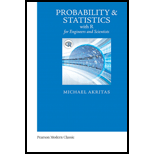
Pearson eText for Probability & Statistics for Engineers and Scientists with R -- Instant Access (Pearson+)
1st Edition
ISBN: 9780137548552
Author: Michael Akritas
Publisher: PEARSON+
expand_more
expand_more
format_list_bulleted
Question
error_outline
This textbook solution is under construction.
Students have asked these similar questions
If X is a continuous random variable
having pdf as shown. Find a) the constant k
b) P(X>1) c) X, X², 0%, standard deviation.
n(x)
k
-2
-1
0
1 2
The joint probability function for the random variables X and Y is
y
0
1
2
P(X, Y) = x0 [3/28 9/28 3/281
=
13/14 3/14
2 1/28 0
0
0
Find Mx, My, E(XY), OXY.
P(x, y) = {e-(x+y) x≥0, y ≥0
0
otherwise
find x, y, x,y
JX, 4
бу
Knowledge Booster
Similar questions
- The joint density function of two continuous random variables X and Y is: p(x, y) = {Kcos(x- Find (i) the constant K + y) 0 0arrow_forwardA random variable X has a Gaussian distribution. The mean value of X is 2 and the variance is 4 volts. Compute the following probabilities: a) P(X3) c) P(X<-2) d) P(2arrow_forwardLet X and Y be random variables having joint density function 0≤x≤1,0≤ y ≤ 1 find X, Y, 0, 0, OXY otherwise p(x,y) = {x+yarrow_forwardFind the probability in tossing a fair coin three times, there will appear a) 3 H b)2 H 1T c) 2 T and 1 H d) 3 T.arrow_forwardLet the random variable X represents the number of automobiles that are used for different business purpose on any given workday. Xi p(xi) 1 0.3 Find: a) μx b)X2 c) o 2 2 3 0.4 0.3arrow_forwardsurvey of 5050 young professionals found that they spent an average of $20.5620.56 when dining out, with a standard deviation of $11.4111.41. Can you conclude statistically that the population mean is greater than $2323? Use a 95% confidence interval. Question content area bottom Part 1 The 95% confidence interval is left bracket nothing comma nothing right bracketenter your response here, enter your response here. As $2323 is ▼ of the confidence interval, we ▼ can cannot conclude that the population mean is greater than $2323. (Use ascending order. Round to four decimal places as needed.)arrow_forwardQ5: 06: the foot lies between 3 and 4. (20 Marks) Let f(x) = 3*, use Lagrange interpolation to find a second-degree polynomial that agrees with this function at the points x₁ = 0, x₁ = 1, x2 = 2.arrow_forwardAnswer questions 8.1.13 and 8.2.10 respectivelyarrow_forwardAnswer questions 8.2.6, 8.2.7 and 8.2.9 respectivelyarrow_forwardAnswer questions 8.1.10, 8.1.11and 8.1.12 respectivelyarrow_forward7.2.10 Researchers in the Hopkins Forest also count the number of maple trees (genus acer) in plots throughout the forest. The following is a histogram of the number of live maples in 1002 plots sampled over the past 20 years. The average number of maples per plot was 19.86 trees with a standard deviation of 23.65 trees. a. If we took the mean of a sample of eight plots, what would be the standard error of the mean? b. Using the central limit theorem, what is the probability that the mean of the eight would be within 1 standard error of the mean? c. Why might you think that the probability that you calculated in (b) might not be very accurate? 2. A normal population has mean 100 and variance 25. How large must the random sample be if you want the standard error of the sample average to be 1.5?arrow_forwardAnswer questions 7.3.10 and 7.3.12 respectively 7.3.12. Suppose that two independent random samples (of size n1 and n2) from two normal distributions are available. Explain how you would estimate the standard error of the difference in sample means X1 − X2 with the bootstrap method.arrow_forwardarrow_back_iosSEE MORE QUESTIONSarrow_forward_iosRecommended textbooks for you
 A First Course in Probability (10th Edition)ProbabilityISBN:9780134753119Author:Sheldon RossPublisher:PEARSON
A First Course in Probability (10th Edition)ProbabilityISBN:9780134753119Author:Sheldon RossPublisher:PEARSON
 A First Course in Probability (10th Edition)ProbabilityISBN:9780134753119Author:Sheldon RossPublisher:PEARSON
A First Course in Probability (10th Edition)ProbabilityISBN:9780134753119Author:Sheldon RossPublisher:PEARSON